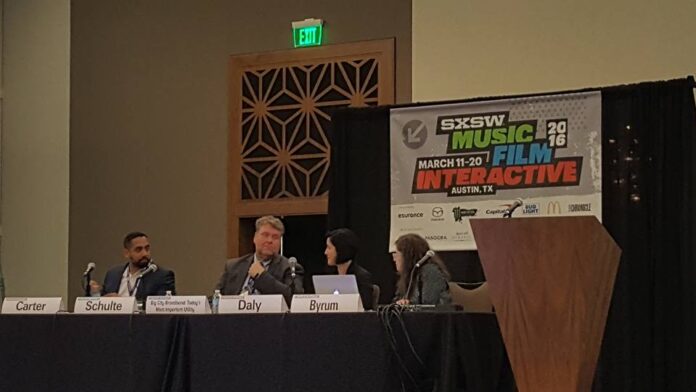South by Southwest panel gathers urban broadband advocates to discuss bridging the digital divide
AUSTIN, Texas – Broadband deployments serve to open up opportunities to largely underserved groups while stimulating larger economic growth, municipal and policy experts agreed during a South by Southwest panel session.
In a March 12 discussion titled “Big City Broadband: Today’s Most Important Utility,” Gary Carter, community broadband manager for Santa Monica, California; Tro Shulte, city manager for Kansas City, Missouri; Kate Daly, SVP for economic transformation at the New York City Economic Development Corporation; and Greta Byrum, senior analyst for the Resilient Communities Program, highlighted the importance of cities actively pursuing broadband rather than “letting the industry decide,” as Byrum put it.
Daly said the goal in New York City is to provide “affordable, reliable, high-speed” broadband to ever resident by 2025, which requires extensive cross agency work.
“One of the big challenges we face is infrastructure,” Daly continued. “Because the regulations and infrastructure can carry such a high bar, it means with that cost it reduces competition. With the reduced competition, of course, the prices stay high and that’s led to a real lack of diversity in the offerings.”
Daly said 22% of households in New York City don’t have Internet access, which creates “digital deserts … that has a huge chilling effect on the economic development in those neighborhoods.”
To combat the lack of broadband access, New York has launched projects including a “library hot spot program” designed to allow library members to check out and take home some 10,000 devices. Then there’s Link NYC, which is replacing phone booths across the five boroughs with Internet kiosks; learn more about that project here.
Shulte reflected on the impact Google Fiber has had in Kansas City, which was among one of the first cities Google selected for its endeavor to become a fiber-to-the-home utility provider. Shulte explained the city waived numerous fees associated with Google’s fiber deployment.
“It was a bit of a risk to the city,” Shulte said. “We were able to come up with a creative strategy to basically waive all our permit fees … which allowed Google to kind of move at an accelerated pace.”
The city manager acknowledged municipalities get focused on streets, bridges, water and sewer systems and more traditional public infrastructure and let broadband take a back seat.
“We became very aware that there was a huge need for what we called a digital inclusion effort to draw the city together,” Shulte said, adding during early registration for Google Fiber, the sign ups broke along “historical economical and racial segregation lines. A $10 registration fee was enough of a barrier to keep people from doing this.”
At that point, Shulte said, the city began to negotiate with Google to maximize the public benefit of the new fiber network including provisioning the broadband service at 300 public facilities including libraries, schools, community centers and the like. That effort is now being extended to publicly owned housing.
“I’d encourage cities, public officials out there, to explore the possibilities and trade what you already have in terms of assets to leverage those investments,” Shulte said.
Carter discussed how since 1996, Santa Monica has pursued a deliberate economic develop strategy, inclusive of broadband, which by 2000 resulted in deployment of a franchise-based fiber network, but with no potential for commercial use. From there the city built an enterprise-grade network and ultimately began leasing dark fiber to Google in 2006.
Carter explained how Santa Monica has a robust postproduction industry supporting the local filmmaking industry. That meant hard drives were regularly couriered from studios to Santa Monica. Realizing the opportunity, the city offered up its broadband network for use.

